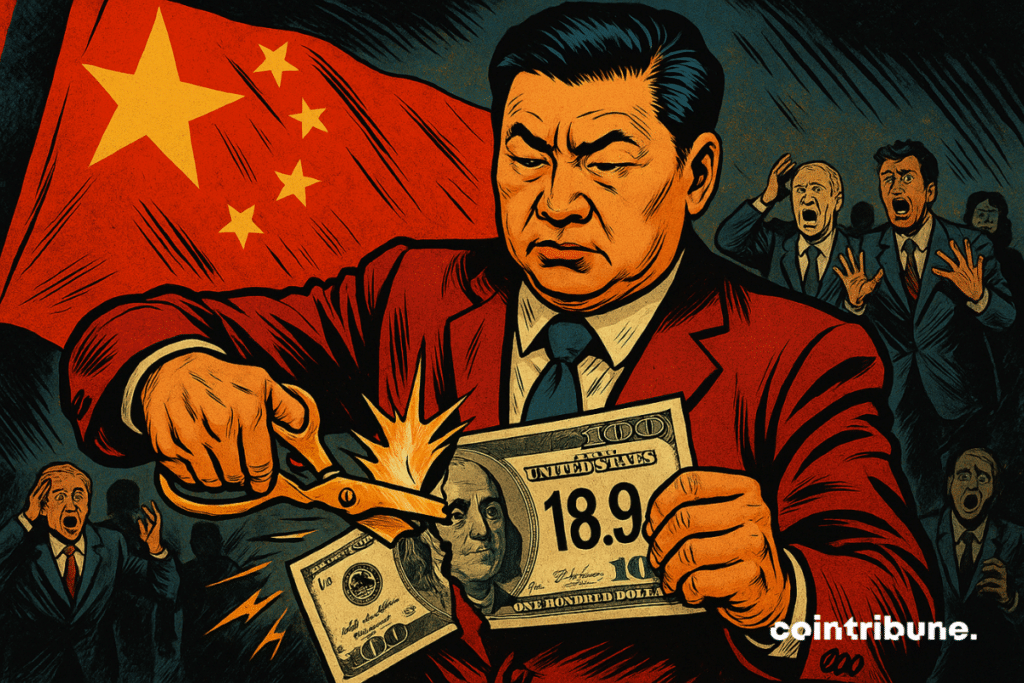8h05 ▪
6
min read ▪ by
The economic relations between Beijing and Washington are marked by turmoil, temporary agreements, and recurring disappointments. The latest example: the suspension of tariff increases for a period of 90 days. But this diplomatic pause offers no guarantee of sustainable stability for the global economy. Moreover, China has just sent a signal with monetary provocation overtones. In March, it massively reduced its holdings of US debt. A decision that risks reigniting tensions.


In brief
- China sells $18.9 billion in US debt and slips to 3rd place globally.
- The United Kingdom surpasses Beijing in holdings, amounting to $779.3 billion.
- Moody’s downgrades the US rating, triggering concerns over US budget sustainability.
- The Chinese economy now prefers to shorten its maturities and quietly diversify its reserves.
Beijing Relents on Treasury Bonds
In March 2025, China sold nearly $19 billion of US Treasury bonds. Its portfolio decreased from $784.3 to $765.4 billion. This significant drop occurs amid a climate of distrust, against the backdrop of a tariff war with the United States. Even though the Trump administration has suspended part of its surtaxes for 90 days, confidence remains shaken.
China thus falls to third place among foreign creditors of the United States. The United Kingdom now surpasses it, with a portfolio valued at $779.3 billion. At the top is Japan, still holding over $1.13 trillion in US bonds.
But this is not a simple repositioning. For many Chinese analysts, this decision aims to protect from an unpredictable US economy. Yu Yongding, former adviser to China’s central bank, states:
China must develop a series of countermeasures through repetitive scenarios. It must protect the security of its overseas assets.
This strategic move also comes at a time when Moody’s downgraded the US sovereign debt rating from “AAA” to “Aa1”. A signal that the US struggles to master its own fiscal trajectory. In this context, Beijing might be tempted to reshape its exposure strategy to the dollar.
Diversify, Shorten, Reposition: The Chinese Economy in Strategic Retreat
This relative disengagement is not synonymous with rupture. Brad Setser, former US Treasury official, analyzes China’s gesture this way: “I think China is seeking to reduce duration rather than exit the dollar.” In other words, Beijing favors short-term bonds, which are more liquid, over longer-term, more volatile bonds.
This decision aligns with a risk reduction logic. In a world where geopolitical tensions intensify, the Chinese economy cannot afford an excessive dependence on a single issuer, even if it is American.
Data from March also reveals the growing prominence of other players:
- Japan: +$22 billion, totaling $1.13 trillion;
- Canada: +$20.1 billion, reaching $426.2 billion;
- Belgium: +$7.4 billion, totaling $402.1 billion (including Chinese accounts);
- Cayman Islands: +$37.5 billion, totaling $455.3 billion.
Meanwhile, the Bloomberg Dollar Spot Index fell by 1.8% in March, increasing market volatility. Additionally, 10-year bond yields rose from 3.86% to 4.59% over the following month.
Despite recent easing following a trade agreement with the United Kingdom and a Sino-American bilateral meeting, instability remains high. Because even if statistics show a global increase in foreign holdings (+$233 billion in March), distrust toward US economic policy persists.
The Global Economy Under Pressure: A Signal with Multiple Interpretations
The decline in Chinese holdings of US debt acts as a thermometer of the international economic climate. Beijing is not abandoning the US markets but methodically adjusting its positions – although there is fear of a possible takeover of bitcoin. The global economy could see this as a prelude to other, more radical future arbitrages.
This transition is reflected through five key indicators:
- $27.6 billion: net amount of Chinese sales in long-term bonds;
- 20 years: first time in two decades that the United Kingdom surpasses China;
- $9.05 trillion: total foreign holdings in Treasury bonds (all-time record);
- 5%: weight of Chinese assets relative to US GDP;
- 90 days: duration of the recently decided Sino-American tariff truce.
This Chinese move does not yet violently disrupt the market. But it sends a message: Beijing can modify its monetary levers at any moment in response to a tariff or political attack. Some analysts see this decision as a stress test: how far can the United States depend on the goodwill of its creditors?
In addition, China’s foreign reserves continue to grow through discreet channels, such as major state banks. These operations partly evade the radar of US Treasury statistics (TIC data), complicating any clear interpretation of flows.
China’s reduction of Treasury bonds resonates as a quiet but powerful alert. At BlackRock, some strategists believe Beijing could turn towards gold or cryptocurrencies as fallback solutions. Because in a perpetually tense globalized economy, monetary independence becomes a strategic, almost vital, tool.
Maximize your Cointribune experience with our “Read to Earn” program! For every article you read, earn points and access exclusive rewards. Sign up now and start earning benefits.
La révolution blockchain et crypto est en marche ! Et le jour où les impacts se feront ressentir sur l’économie la plus vulnérable de ce Monde, contre toute espérance, je dirai que j’y étais pour quelque chose
DISCLAIMER
The views, thoughts, and opinions expressed in this article belong solely to the author, and should not be taken as investment advice. Do your own research before taking any investment decisions.

